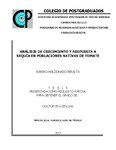| dc.description.abstract | La diversidad ambiental de México ha permitido el desarrollo de diferentes formas silvestres y cultivadas de tomate (Solanum lycopersicum L.) cuyos frutos se comercializan local y regionalmente en diferentes estados del país. Este trabajo se realizó con el objetivo de evaluar en campo y en condiciones protegidas de invernadero con fertirriego automatizado el desempeño fisiológico de variedades nativas de tomate mexicano en cuanto a su capacidad y eficiencia del crecimiento, en comparación con al menos una variedad comercial de tomate. En campo se midieron variables agronómicas y de calidad de fruto, y en invernadero se midió además acumulación de biomasa, eficiencia del crecimiento y eficiencia en el uso del agua como variables fisiológicas. Los resultados muestran que las poblaciones nativas de tomate cultivadas en condiciones de campo abierto en el que hubo granizadas e incidencia de plagas y enfermedades, condiciones en las que todos los genotipos de tomate mostraron bajo crecimiento y pobre rendimiento, pero algunos de ellos sobresalieron en morfología de planta y fruto. Por ejemplo, la población nativa G3 presentó el valor mayor en rendimiento en campo con 10.85 kg m-2 que superó al híbrido comercial que produjo 5 kg m-2; esta variedad G3 generó 121 frutos por planta de 74.3 g por fruto, y fruto con forma de calabaza de 8 a 9 lóculos. En condiciones protegidas de invernadero las poblaciones nativas de tomate mexicano también mostraron amplia variabilidad morfológica en planta y fruto, así como importantes diferencias fisiológicas. Así destacó el híbrido testigo por alcanzar la mayor acumulación de biomasa total y el mayor rendimiento de fruto por planta, con un manejo sin poda. Entre las poblaciones nativas destacó la de Campeche (CAM) que asignó 61 % de la biomasa total a la formación de fruto, al igual que el testigo. En un manejo a cuatro racimos el HIB testigo y la población OAX 100 % rindieron la misma cantidad de fruto, con 3.7 y 3.6 kg/planta. Por su parte, cuando se aplicó déficit hídrico durante casi todo el ciclo (25 % del riego completo) se provocó una severa reducción en el rendimiento en todos los genotipos (CAM: 26 %, EMX: 31 %, HIB: 55 %, OAX: 64, y PUE: 63 %), donde destacan dos genotipos nativos en los que el efecto del estrés fue menor. El mayor rendimiento a crecimiento indeterminado (150 días después del trasplante) y con riego completo (100 %) lo produjo el HIB con 3.3 kg/planta y las plantas CAM solo produjeron 2.5 kg/planta con una diferencia de 800 g. En cambio, cuando se aplicó el tratamiento de estrés al 25 % el HIB testigo rindió 400 g menos de fruto por planta que el genotipo nativo CAM. De lo anterior se concluye que hay poblaciones nativas de tomate con características fisiológicas o morfológicas superiores al híbrido testigo, como tolerancia a sequía y a la pudrición apical, por su tasa fotosintética, y con tan buena partición de biomasa hacia el fruto como la del híbrido mejorado. _______________ GROWTH ANALYSIS AND DROUGHT RESPONSE IN NATIVE TOMATO POPULATIONS. ABSTRACT: Mexico's environmental diversity has allowed the development of different wild and cultivated tomato forms whose fruits are marketed locally and regionally in different states of the country. This work was done with the objective of evaluating the physiological response of native varieties of Mexican tomato in terms of their capacity and growth efficiency, in comparison with at least one commercial variety of tomato, in the field and in protected conditions of greenhouse with automated fertigation. In the field, agronomic and fruit quality variables were measured, and in greenhouse were also measured accumulation of biomass, growth efficiency and water use efficiency as physiological variables. The results showed that native tomato populations cultivated under open field conditions in which hailstones and pests and diseases occurred, conditions in which all tomato genotypes showed low growth and poor yield, but some of them stood out in plant morphology and fruit. For example, the native G3 population in field presented the highest yield with 10.85 kg m-2, which exceeded the commercial hybrid (5 kg m-2); this G3 variety generated 121 fruits per plant of 74.3 g per fruit, and pumpkin shaped fruit of 8 to 9 locules. In greenhouse conditions , the native populations of mexican tomato also showed wide morphological variability in plant and fruit, as well as important physiological differences. This highlighted the hybrid control for achieving the largest accumulation of total biomass and the highest yield of fruit per plant, without pruning. Among the native populations, the Campeche (CAM), which assigned 61% of the total biomass to the fruit formation, stood out among the native populations, as also did the control. In a four-cluster management of the tomato plants the control HIB and the OAX 100 % yielded the similar amount of fruit, 3.7 and 3.6 kg per plant, respectively. On the other hand, when water deficit was applied during almost all the cycle (25 % of the complete irrigation) a severe reduction in yield in all the genotypes was caused (CAM: 26 %, EMX: 31 %, HIB: 55 %, OAX: 64, and PUE: 63 %), and two native genotypes clearly outstand in which the stress effect was lower. The highest yield at indeterminate growth (150 days after transplanting) and complete irrigation (100%) was produced by the HIB with 3.3 kg per plant and the CAM plants only produced 2.5 kg per plant with a difference of 800 g. In contrast, when the stress treatment was applied at 25 %, the control HIB yielded 400 g less fruit per plant than the native genotype CAM. From the above, it is concluded that there are native populations of tomato with physiological or morphological characteristics superior to the control hybrid, such as tolerance to drought and apical fruit rot, due to their photosynthetic rate, and with an outstanding biomass partition to the fruit as the improved hybrid. | es_MX |


